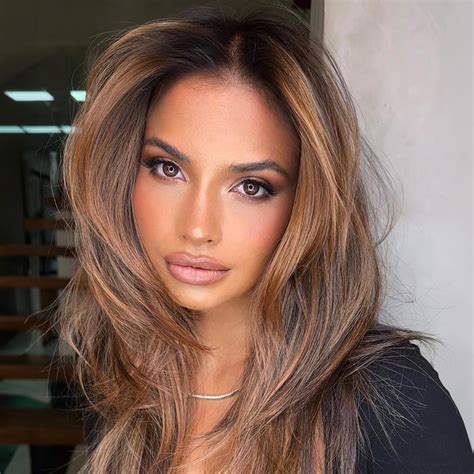What is Balayage Hair Color?
Balayage is a French hair coloring technique that involves hand-painting hair to create a natural-looking, sun-kissed effect. Unlike traditional foil highlights, balayage doesn’t use foils or caps, allowing for a more seamless blend of colors.

How is Balayage Done?
- Section Hair: Divide hair into small sections and secure with clips.
- Apply Lightener: Hand-paint lightener onto strands in vertical strokes, focusing on the ends and mid-lengths.
- Develop Lightener: Process lightener according to manufacturer’s instructions, typically for 20-30 minutes.
- Rinse and Tone: Rinse lightener thoroughly and apply toner to balance color and add warmth or coolness.
- Style: Blow-dry and style hair to reveal the final look.
Benefits of Balayage Hair Color:
- Natural-Looking: Balayage creates subtle, blended color transitions that mimic the hair’s natural sun-bleached effect.
- Low Maintenance: Regrowth is less noticeable than with traditional highlights, reducing the frequency of salon visits.
- Versatile: Balayage can be customized to suit any hair color and style, from blondes to brunettes to redheads.
- Low Damage: Hand-painting limits the use of chemicals, minimizing potential hair damage.
Drawbacks of Balayage Hair Color:
- Time-Consuming: Balayage is a time-intensive process, typically taking several hours to complete.
- Costly: Balayage can be more expensive than traditional highlights due to the skill and artistry required.
- Not Suitable for All: Balayage may not be suitable for very short or very dark hair, as the technique requires a certain amount of hair length and darkness to blend effectively.
4 Types of Balayage Hair Color:
| Type | Description |
|---|---|
| Classic Balayage: Creates subtle, sun-kissed highlights that blend smoothly into the base color. | |
| Ombré Balayage: Gradual color transition from dark roots to lighter ends. | |
| Babylight Balayage: Very fine, delicate highlights that create a soft, natural effect. | |
| Reverse Balayage: Lightens roots while darkening ends, creating a dramatic, dimensional look. |
Choosing the Right Balayage for You
Consider your:
- Hair Color: Balayage works best on hair that is naturally medium to dark brown or blonde.
- Hair Length: Balayage is most effective on hair that is at least shoulder-length or longer.
- Face Shape: Soft balayage highlights can balance features, while bolder ombré can elongate a round face.
- Skin Tone: Warm balayage tones complement fair skin, while cooler tones suit darker skin tones.
Balayage Hair Color Trends
According to research by Lux Research, the global hair care market is projected to reach $19.9 billion by 2025. Within this market, balayage is emerging as a dominant trend:
- Money Piece Balayage: Highlights framing the face, creating a flattering accent.
- Bronde Balayage: Blending blonde and brown tones for a dimensional, natural look.
- Caramel Balayage: Warm, golden highlights that add depth and richness.
- Icy Balayage: Cool, platinum highlights that create a sophisticated, edgy effect.
Balayage vs. Highlights: What’s the Difference?
| Feature | Balayage | Highlights |
|---|---|---|
| Technique | Hand-painted | Foiled or capped |
| Result | Natural, blended | More defined, bolder |
| Maintenance | Lower | Higher |
| Cost | Higher | Lower |
| Damage | Lower | Higher |
DIY Balayage: Is it Possible?
While home balayage is possible, it is highly recommended to seek professional assistance for optimal results. DIY balayage can lead to uneven application, brassy tones, or permanent damage to hair.
Balayage Hair Color Maintenance Tips
- Use Color-Protecting Shampoo: Opt for shampoos specifically designed for color-treated hair to prevent fading.
- Apply Conditioner Regularly: Condition your hair every time you wash it to keep it healthy and prevent breakage.
- Limit Heat Styling: Excessive heat styling can damage color-treated hair. Use heat protectants before using hot tools.
- Get Regular Trims: Regular trims remove split ends and promote healthy hair growth.
Balayage Hair Color Inspiration
[Image of classic balayage on blonde hair]
[Image of ombré balayage with dark roots and light ends]
[Image of babylight balayage creating a soft, natural effect]
[Image of reverse balayage with lightened roots and darkened ends]
Conclusion
Balayage hair color is a transformative technique that creates natural-looking, sun-kissed highlights. With its versatility and low maintenance, balayage is a popular choice for those seeking a subtle yet stunning color upgrade. Whether you prefer classic, ombré, babylight, or reverse balayage, there’s a style to complement your hair color, skin tone, and face shape. Embrace the beauty of balayage and let your locks shine!
